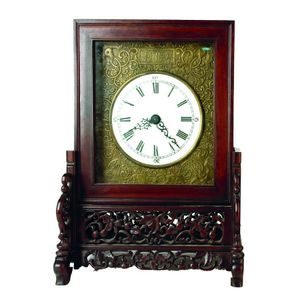Chinese Table Clock with Verge Escapement and Ornate Case
You must be a subscriber, and be logged in to view price and dealer details.
Subscribe Now to view actual auction price for this item
When you subscribe, you have the option of setting the currency in which to display prices to $Au, $US, $NZ or Stg.
- Embossed / Repousse - Embossing, also known as repousse, is the technique of decorating metal with raised designs, by pressing or beating out the design from the reverse side of the object.It is the opposite of chasing, where the decoration is applied from the front. An embossed or repoussed object may have chasing applied to finish off the design.
- Verge Escapement - A verge escapement is an early mechanical escapement used in clocks and other timekeeping devices. It is an early form of the escapement mechanism, which is used to regulate the movement of the hands of a clock or watch. The verge escapement consists of a vertical shaft called the verge, which is mounted on the clock's main plate. Attached to the verge are two pallets, which engage with the teeth of the escape wheel. As the escape wheel turns, the pallets alternately lock and release it, allowing the movement of the clock to be regulated. The verge escapement was widely used in early mechanical clocks, but it was eventually replaced by the more accurate and reliable anchor escapement.
- Fusee - The fusee movement was used in clocks and pocket watches from the mid 17th century. The fusee is a cone shaped drum within the works that is linked to the barrel of the spring, usually by a length of chain.
As the mainspring loses its tension over time, the cone shaped barrel compensates for this by increasing the tension, by pulling the mainspring tighter, thus ensuring the time remains constant.
Use of the fusee in clocks was superseded by the "going barrel" in the mid 19th century and for pocket watches at the beginning of the 19th century.
The fusee continued to be used in marine chronometers until the 1970s.
This item has been included into following indexes:
Visually similar items

A Chinese rosewood cased mantel clock, with fusee chain drive, bell striking mechanism; the white enamel dial with Roman numerals set in an embossed copper face, the case with slide-up doors to front and back raised on a stand carved and pierced with Orien

A 19th century French carriage clock, with Champleve enamel panelled corners, the clock with chased enamelled dial with Arabic numerals and an open escarpment, with an eight day movement. Retailer Wray Son & Perry Birmingham

A Regency period mahogany cased bracket clock, the lancet case inlaid and mounted with brass, lion mask handles to the sides above the conforming shape gilded grilles, the circular cream enamel dial named J. Walker, London, the fusee movement with hour and

American mantel clock with Roman Numerals and eight day movement 29 cm high
